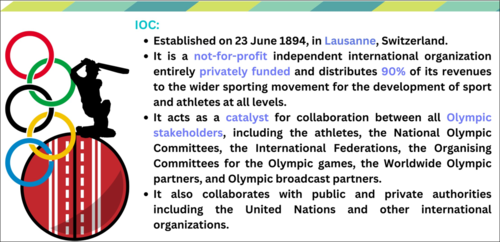Supreme Court’s verdict on same-sex marriage
A five-judge Constitution Bench headed by Chief Justice of India (CJI) D Y Chandrachud on 17 October 2023 unanimously declined to recognise same-sex marriages. The Bench, also comprising Justices Sanjay Kishan Kaul, Ravindra Bhat, Hima Kohli, and P S Narasimha, in a 3-2 majority verdict, also declined to allow civil unions for non-heterosexual couples.
Key takeaways from the verdict
- ONE, all five judges on the Bench, including the CJI and Justice Kaul, who batted for civil unions, agreed that there is no fundamental right to marry under the Constitution.
- TWO, all five judges also unanimously agreed that it is not possible to tweak the Special Marriage Act, 1954 by using gender neutral language to allow same-sex marriage.
- THREE, four of the five judges wrote individual opinions. while the CJI and Justice Kaul wrote minority opinions in favour of extending civil union to same-sex couples.
- FOUR, on the “bouquet of rights”, all five judges took note of the Centre’s stand that a high-level Cabinet committee will look into rights that can be conferred on non-heterosexual couples.
- FIVE, the minority view by CJI Chandrachud and Justice Kaul struck down specific guidelines by the Central Adoption Resource Authority (CARA) to the extent that it disallows same-sex or unmarried couples from jointly adopting a child.
What is a civil union?
- A “civil union” refers to the legal status that allows same-sex couples specific rights and responsibilities normally conferred upon married couples.
- Although a civil union resembles a marriage and brings with it employment, inheritance, property, and parental rights, there are some differences between the two.
What is the Special Marriage Act?
- The Special Marriage Act of 1954 (SMA) was passed by the Parliament on 9 October 1954.
- It governs a civil marriage where the state sanctions the marriage rather than the religion.
- Issues of personal law such as marriage, divorce, adoption are governed by religious laws that are codified. These laws, such as the Muslim Marriage Act, 1954, and the Hindu Marriage Act, 1955, require either spouse to convert to the religion of the other before marriage.
- However, the SMA enables marriage between inter-faith or inter-caste couples without them giving up their religious identity or resorting to conversion.
- The Indian system, where both civil and religious marriages are recognised, is similar to the laws in the UK’s Marriage Act of 1949.
- An earlier version of the SMA was enacted in 1872 and was later re-enacted in 1954 with provisions for divorce
SC direction regarding queer community
- The Supreme Court of India has issued directives to both the Union government and state governments regarding same-sex marriage. The court's verdict aims to prevent discrimination against the queer community based on their sexual orientation. Here are the key directives:
- Non-Discrimination: The government must ensure that there is no discrimination against the queer community in terms of access to goods and services.
- Public Awareness: Efforts should be made to sensitize the public about the rights of the queer community.
- Helpline for Queer Community: A dedicated helpline should be established to provide support and assistance to the queer community.
- Safe Houses: Safe houses should be created to offer protection to queer couples who may face threats or harassment.
- Inter-Sex Children: Inter-sex children should not be subjected to forced operations.
- Formation of Committee: The SC recorded the statement of the Solicitor General that the Union government will constitute a committee to decide the rights and entitlements of persons in queer unions. The issues before the committee will be mentioning queer couples as family in ration cards, allowing queer couples to nominate for joint bank account, allowing them all the rights that from pension, gratuity, etc..
The Supreme Court has also issued specific directions to the police:
- No Harassment: Police should not harass queer couples by summoning them to police stations or visiting their residences solely to inquire about their gender identity or sexual orientation.
- Freedom of Choice: Queer individuals should not be forced to return to their families if they do not wish to do so.
- Protection of Freedom: When queer individuals file complaints alleging that their family is inhibiting their freedom of movement, the police should verify the genuineness of the complaint and ensure their freedom is not curtailed.
- Protection against Violence: If a complaint is filed apprehending violence from the family due to the complainant's queer identity or relationship, the police should verify the genuineness of the complaint and provide appropriate protection.
- Preliminary Enquiry: Before registering an FIR against a queer couple or an individual in a queer relationship, the police should conduct a preliminary enquiry to determine if the complaint discloses a cognizable offense, following the guidelines set in the Lalita Kumari vs Government of UP case.
- These directives aim to safeguard the rights and well-being of the queer community, ensuring equality and protection under the law.
CBDT simplifies angel taxation norms for start-ups
GS Paper III
Context:
The Central Board of Direct Taxes (CBDT) has directed its officers to not carry out scrutiny of angel tax provisions for start-ups recognised by the Department for Promotion of Industry and Internal Trade (DPIIT).
Issues faced by Startups with angel tax
- The angel tax created perplexity and burstiness among startups and investors. It often led to tax demands and premiums paid by investors, even when the investments were genuine and made at fair market value.
- This deterred investment in startups and was seen as a significant hurdle to entrepreneurship.
- However, amidst the directive of DPIIT, there is a ray of hope for the startups to flourish better than earlier.
What is the new directive?
- This clarification by the tax department comes after many startups had raised concerns about receiving scrutiny notices for angel tax.
- With this directive of CBDT, the recognized start-ups will not be verified for cases pertaining to Section 56 (2) (vii)(b) of the Income-tax Act, which was amended in the Finance Act, 2023 bringing in non-resident investors also under the angel tax levy.
|
Angel Tax:
|
Changes brought by budget 2023 regarding angel tax rules:
- In the budget for the fiscal year 2023-24 which spans from April 2023 to March 2024, significant changes were introduced to angel tax.
- Under this budget, foreign investment in startups was brought under this ambit. This meant that the excess premium on these investments would be considered as ‘income from sources and taxed at a rate exceeding 30%. Earlier, it was imposed only on investments made by a resident investor.
|
Startups:
|
Significance of the amendment in Budget 2023:
- The recent amendments in the Budget 2023 have brought significant changes to the scope of Angel Tax, impacting startups across India. DPIIT-recognized startups have found respite in the form of CBDT circular, which exempts them from scrutiny related to Angel Tax.
- This administrative guidance ensures that recognized startups can operate with greater ease and encourages more businesses to seek DPIIT recognition.
- With this support, the Indian startup ecosystem can thrive and innovate, driving economic growth and job creation.
Suggestions to improve the functioning of startups:
- Enhance skill development: Programs that enhance skill development and vocational training, such as the Skill India initiative, can help create a pool of talent.
- Reducing competition: Startups should benefit from government efforts to facilitate export to international markets, reducing competition domestically.
- Protecting intellectual property: The government should support startups to protect their intellectual property by providing more accessible and affordable resources for IP registration and awareness.
- Improving infrastructure and connectivity: The government should invest in improving infrastructure and expanding broadband access in rural areas in order to support startups such as Agritech Company in reaching and empowering farmers in remote regions.
- Easing investment regulations: The government could work on enhancing the availability of funds and easing investment regulations.
- Easing bureaucratic hurdles: The government has already taken steps to ease the bureaucratic hurdles, but more work needs to be done in this direction.
Conclusion:
While some steps have been taken to alleviate the angel tax issue for startups, there still remain significant concerns and challenges within the startup ecosystem. The government, in collaboration with the private sector, should work to create a more conducive environment for startups, thereby fostering innovation and economic growth in the country.
Q1. What does venture capital mean? (UPSC 2014)
(a) A short-term capital provided to industries
(b) A long-term start-up capital provided to new entrepreneurs
(c) Funds provided to industries at times of incurring losses
(d) Funds provided for replacement and renovation of industries
Long-term Risk of Artificial Intelligence
GS Paper – III
Context:
In a recent statement by the Center for AI Safety, more than 350 AI professionals have voiced their concerns over the potential risks posed by AI technology.
About Artificial Intelligence:
- Artificial intelligence (AI) is the theory and development of computer systems capable of performing tasks that historically required human intelligence, such as recognizing speech, making decisions, and identifying patterns.
- AI is an umbrella term that encompasses a range of technologies, including machine learning, deep learning, and natural language processing (NLP).
Applications of AI:
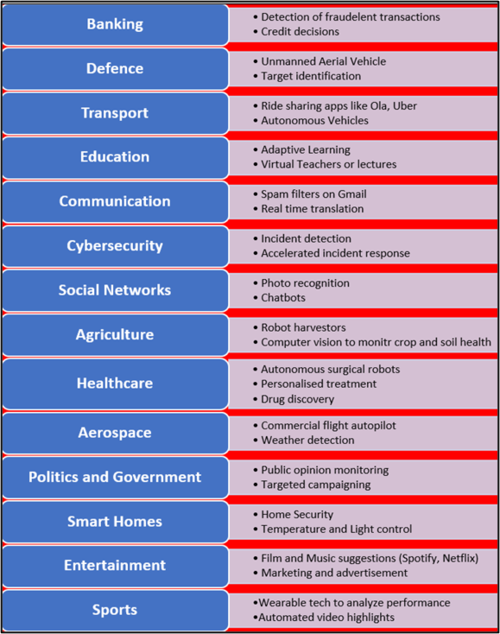
Challenges associated with AI:
- Political concerns:
- AI can be used to negate freedom and democracy by censoring, constraining, repressing or disempowering people; posing a threat to peace and stability of the nation. For e.g.
- China is racially profiling ethnic minorities through facial recognition techniques (FRT) and creating separate habitations for them.
- Ethical and Moral concerns:
- AI poses moral questions of accountability in several cases. For e.g. –
- If a self-driving car hits someone, who will be held responsible? the owner of the car or the programmer who made a code for the car.
- Deepfakes of women and children used in pornography.
- AI poses moral questions of accountability in several cases. For e.g. –
- Technological concerns:
- Technological hegemony can be created by developed nations using AI at the cost of developing nations. By the time technology reaches developing nations, various barriers can be cropped up for developing nations to limit AI’s use.
- AI gives rise to various cybercrimes. A recent example is of scamming money from people by creating deepfake videos of their close ones asking for money.
- Security concerns:
- AI could aid reckless quest for proliferation of weapons of mass destruction by state and non- state actors alike. Various treaties signed and agreed upon till now could become redundant if this happens. E.g., statute of IAEA, outer space treaty, NPT, etc.
- Infiltration across the borders is a concern, furthermore the Fake Currency Notes (FCN) designed through AI can break a nation’s economy.
- Risk to public well-being:
- If essential infrastructure such as water and electricity increasingly rely on AI.
- Any malfunction or manipulation of such AI systems could disrupt these pivotal services, potentially hampering societal functions.
- Outpacing Human intellect:
- AIs might undergo rapid self-improvement, culminating in a super-intelligence that far outpaces human intellect.
- The potential of this super-intelligence acting on misaligned, corrupted or malicious goals presents dire scenarios.
- Non-alignment with human values:
- The challenge lies in aligning AI with universally accepted human values. The rapid pace of AI advancement, spurred by market pressures, often eclipses safety considerations.
- AI can be used to negate freedom and democracy by censoring, constraining, repressing or disempowering people; posing a threat to peace and stability of the nation. For e.g.
- Lack of unified global regulations:
- The world does not have a unified approach to the deployment of AI.
- Nations engaging in rigorous AI safety protocols may be at a disadvantage, encouraging them to loosen their regulatory frameworks to maintain competitiveness, thereby further compromising global AI safety.
Provisions regarding the regulation of AI in India:
- Information Technology Act, 2000:
- Although it does not explicitly mention AI, specific provisions within the Act are applicable to AI-related activities.
- Section 43A of the IT Act enables compensation in case of a breach of data privacy resulting from negligent handling of sensitive personal information. This provision is particularly relevant in the context of AI systems that process user data.
- Justice K.S. Puttaswamy (Retd.) v. Union of India (2017), case: The Supreme Court of India emphasized the need to safeguard personal data from AI-based systems.
- New Education Policy: The Indian government recently launched its NEP which mentioned about provisions regarding special coding classes for students of 6th standard.
- AIRAWAT: Recently Niti Ayog, (planning commission of India) also launched AIRAWAT which stands for AI Research, Analytics and Knowledge Assimilation platform which considers all the necessary requirements of AI in India.
Conclusion:
Countries must not fall into the trap of loosening their regulatory frameworks to maintain competitiveness. Nations must delineate where AI deployment is unacceptable and enforce clear norms for its role in warfare. In this ever-evolving landscape of AI risks, the world must remember that our choices today will shape the world we inherit tomorrow.
PYQs
- With the present state of development, Artificial Intelligence can effectively do which of the following: (UPSC 2020)
- Bring down electricity consumption in industrial units
- Create meaningful short stories and songs
- Disease diagnosis
- Text-to-Speech Conversion
- Wireless transmission of electrical energy
Select the correct answer using the code given below:
- 1, 2, 3 and 5 only
- 1, 3 and 4 only
- 2, 4 and 5 only
- 1, 2, 3, 4 and 5
Mains
- How is science interwoven deeply with our lives? What are the striking changes in agriculture triggered off by science-based technologies?
(UPSC 2020)
- “The emergence of the Fourth Industrial Revolution (Digital Revolution) has initiated e-Governance as an integral part of government”. Discuss.
Palliative Care: A way to reduce financial distress for people with life-limiting diseases.
Why in the News?
India is becoming the epicentre for non-communicable diseases and several of the patients with these diseases like cancer, cardiac diseases, renal failure, or stroke, will eventually reach an incurable stage.
What is Palliative care?
Palliative care is an interdisciplinary approach that aims at improving the quality of life of both terminally ill patients and their caregivers. It provides physical, emotional, psychosocial, spiritual, and rehabilitative interventions.
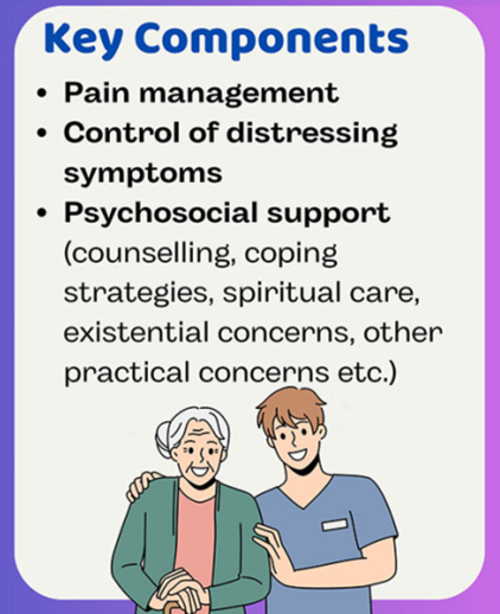
Need of Palliative Care in India:
- Origin: The concept of palliative care was introduced in India in the mid-1980s, and the Medical Council of India launched the MD Palliative Medicine post-graduate programme in 2012.
- Statistics: It is estimated that nearly 5.4 million patients need palliative care every year. However, it's accessible to only 1% of them. India currently ranks 59 out of 81 countries in the Quality of Death Index.
- Health Care infrastructure in India:
- A larger number of patients in India come to the hospital at more advanced stages of the disease, therefore they end their treatment at tertiary care hospitals.
- This adds to the cost of care for the patients, fatigue, burnout for the healthcare team and improper use of the infrastructure and resources in these apex centres.
- Palliative care services do not require tertiary care facilities. Enabling care of such patients at a local secondary care hospital is a more cost-effective and more efficient use of health care resources.
What are the issues faced during the implementation of Palliative care in India?
- The Rising Cost of Health: Non-communicable diseases will pull many people into poverty because these diseases require long-term treatment and periodic health check-ups. This leads to ‘financial toxicity’.
- Limited availability of services: Several trends in health care today decrease the chances of cancer patients having access to palliative care. These range from the limited availability of palliative care services to the philosophy of patient care that dominates our health care system in India. Another aspect of care that is clearly lacking in current healthcare systems is communication about patient goals and preferences for care.
- Lack of Investment: Only 1.35% of GDP is being spent on healthcare services where patient bears the maximum proportion of the bills.
- Non-availability of funds: Currently, the state government is not sure whether the money will continue to be available in the subsequent year. This prevents long-term planning.
- Medical Insurance: Medical insurance does not play a significant role in hospice and palliative care provision in India. With a small number of healthcare professionals struggling to attend to millions and millions with various diseases, it is difficult for the average doctor to set aside time from his curative practice for palliative care.
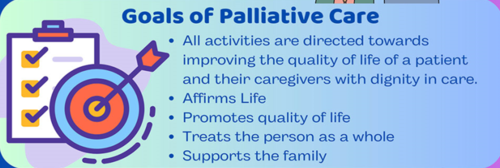
Way ahead:
- Governmental policy, Education, and Drug availability: WHO recommended three foundation measures for developing Palliative care - Governmental policy, Education, and Drug availability. They are important for establishing sustainable Palliative care and achieving meaningful coverage.
- Incorporating funding mechanism: The funding mechanism of the National Program for Palliative Care needs to be reorganized. Instead of its current mode of occasional annual budgeting, the program must be consistently funded.
- Incorporating palliative care into the Indian healthcare system: Considering that palliative care will not only eventually reduce out-of-pocket expenditure for the patients but also save government expenditure on health care. Therefore, investing in Palliative Care is an extremely wise decision.
- Need for patient-centred care: The patient-centred care broadens the focus and requires clear coordination across specialities and disciplines and access to palliative care physicians and nurses. The goal of palliative care should continue to focus on the relief of suffering and the improvement of the quality of life for patients with advanced illnesses.
- Can be a win-win situation: The inclusion of palliative care can result in improvement in bed utilization, the bed can be used to save a life as opposed to a patient occupying a bed with long-term disease. This will bring more success and fame to hospital corporates. Secondly, it is also helpful in reducing financial toxicity for the families as well as the patient because “a dignified death is every human’s right”.
Conclusion:
It is the moral obligation of the health system to take care of people, especially when they are suffering from life-long and life-limiting illnesses. Early initiation of palliative care in patients with advanced disease has been shown to reduce health expenditure by up to 25%.
PYQs
- Appropriate local community-level healthcare intervention is a prerequisite to achieving ‘Health for All’ in India. Explain (2018)
- “Besides being a moral imperative of a Welfare State, primary health structure is a necessary precondition for sustainable development.” Analyze. (2021)
Supreme Court rejects plea to end 26-week pregnancy
GS Paper I, II
Context:
The Supreme Court declined permission to a married woman to terminate her over 26-week pregnancy after the AIIMS medical board had confirmed that the pregnancy was not a cause of immediate danger to her life or the foetus. It has raised crucial questions on the decisional autonomy of a woman to abort, and the legislative framework.
Background:
- According to the study by the Foundation for Reproductive Health Services (FRHS-NGO) in Delhi, Maharashtra, Rajasthan and Uttar Pradesh –
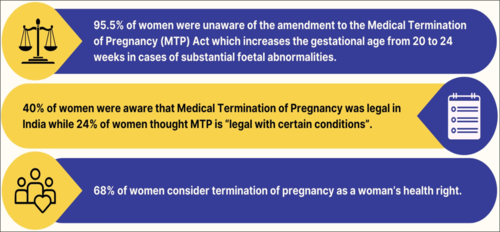
About:
- Earlier a two-judge Bench of Justices Hima Kohli and B V Nagarathna, allowed the termination of the pregnancy.
- However, AIIMS, Delhi, wrote to the SC that it would need a directive on whether a foeticide (stopping the foetal heart) can be done before termination since the foetus is “currently viable”. The Union Government later filed an application seeking recall of the order in the light of a medical report.
- The 2-judge bench could not reach a consensus and the matter was placed before a three-judge Bench headed by Chief Justice of India (CJI) D Y Chandrachud.
- The 3-judge bench said that the women cannot claim an absolute overriding right to abort. Section 5 of the MTP act allows abortion only if the pregnancy poses an actual, physical and immediate danger to a woman’s life and health.
Law on abortion:
- The Medical Termination of Pregnancy Act (MTP Act) allows the termination of pregnancy in three stages –
- Stage 1: Termination of pregnancy up to 20 weeks is allowed on the advice of one doctor.
- Stage 2: If a pregnancy is 20-24 weeks, the right to seek abortion is determined by two registered medical practitioners as an exception, only under certain categories like forced pregnancies, rape in case of minors or sexual assault, women with disabilities, change in the marital status of women during pregnancy.
- Stage 3: After 24 weeks, a medical board must be set up in “approved facilities”, which may “allow or deny termination of pregnancy” only if there is substantial foetal abnormality.
- Concerns:
- The decision to terminate after 20 weeks is shifted to doctors and not the woman.
- The legal framework on reproductive rights tilts to the side of the woman’s autonomy to decide and choose more than the rights of the unborn child.
Concept of Foetal viability:
- It means the ability of the foetus to survive post-delivery. Foetal viability in the 1970s was pegged at 28 weeks, which is now with scientific advancement lower at 23-24 weeks.
- Abortion is lawful or accessed with less difficulty, before the point that a foetus is deemed viable. After viability, abortion is lawful in a narrower set of circumstances.
- Foetal viability is determined based on physical characteristics indicating if the foetus has reached an expected stage of development and the general appearance including cyanosis, the placental blood and cord, and skin colour.
- The landmark 1973 US Supreme Court verdict in Roe v Wade that made abortion a constitutional right allowed abortion up to the point of foetal viability, that is the time after which a foetus can survive outside the womb.
- While courts have read the MTP Act liberally, the test of “foetal viability” as a benchmark for consideration of abortion is new in India.
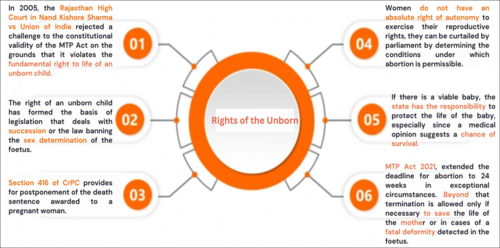
Reproductive rights of Women:
- Access to safe and legal abortion is a matter of bodily autonomy - deciding the number and spacing of children and enjoying the benefits of scientific progress and its availability.
- Paramount consideration should be given to the mother, her conscious decision to not have the baby should be respected.
- Forcing a woman to continue a pregnancy endangering her health would be violative of her fundamental rightse., non-discrimination, equality, life, health, and privacy.
- The gestation period in pregnancy as a basis to allow or deny abortion is an artificial construct. The 2022 WHO Abortion Care Guidelines recommend against laws that prohibit abortion based on the gestational age limit.
- Forcing a pregnant individual to carry an unwanted pregnancy to full term can result in severe psychological trauma and may be seen as a form of torture, infringing upon her mental health.
- Earlier this year, the SC granted permission for abortion primarily based on the “risk to mental health” of the pregnant person.
- In 2022, the Kerala High Court allowed a later-term termination on grounds of mental health.
Way forward:
- There is a need for a humanitarian approach & balanced decision, it is imperative to ensure that abortion remains safe, legal, affordable and accessible in a timely manner, without causing additional hardship to pregnant persons.
- The argument against the liberalization of the MTP act is that it will result in the killing of the unborn baby, especially the girl child. But again, there are both good and bad aspects of the situation. All these can be controlled by strict law enforcement and monitoring agencies like the PNDT Act and the government health departments.
- Moreover, the healthcare scenario needs to be at par and the basic antenatal health care program should be given priority. This will further reduce abortion litigation cases.
License fee paid by telcos to be treated as CapEx
Context:
In a setback for telecom operators, the Supreme Court held that license fees paid by them should be treated as capital expenditure and not revenue expenditure.
Capital expenditure:
- Capital expenditures (CapEx) are funds used by a company to acquire, upgrade, and maintain physical assets such as property, plants, buildings, technology, or equipment.
- CapEx is often used to undertake new projects or investments by a company.
- This type of financial outlay is made by companies to increase the scope of their operations or add some future economic benefit to the operation.
- Capital expenditures are long-run investments that benefit the company for more than one year. Expenditure of a capital nature is not allowed as a deduction when calculating trading profits.
Revenue expenditure:
- Revenue expenditures are short-term expenses used in the current period or typically within one year.
- Revenue expenditures include the expenses required to meet the ongoing operational costs of running a business and thus are essentially the same as operating expenses (OPEX).
- The revenue expenditure is generally fully deductible from taxable income in the year they incurred.

Global Maritime India Summit, 2023
Context:
The Prime Minister of India will inaugurate the third edition of the Global Maritime India Summit (GMIS) 2023. The summit will be held from 17th to 19th October at MMRDA Grounds in Mumbai.
Highlights:
- The foundation stone of projects worth more than Rs 23,000 crore will be laid which is aligned with the 'Amrit Kaal Vision 2047’ for the Indian maritime blue economy.
- Prime Minister will lay the foundation stone of the Tuna Tekra all-weather deep draft terminal, to be built at a cost of more than Rs. 4,500 crores at Deendayal Port Authority in Gujarat.
- The terminal, which is likely to emerge as an international trade hub, will handle next-gen vessels exceeding 18,000 twenty-foot equivalent units (TEUs) and will act as a gateway for Indian trade via the India-Middle East-Europe Economic Corridor (IMEEC).
About the summit:
- The summit is the biggest Maritime Event in the country. It will witness the participation of Ministers from across the globe representing countries from Europe, Africa, South America, and Asia (including central Asia, the Middle East and BIMSTEC region).
- The first Maritime India summit was held in 2016 in Mumbai. The Second Maritime Summit was held virtually in 2021.
Inclusion of Cricket in the Olympics
Context:
Recently an International Olympic Committee (IOC) meeting was held in Mumbai.
About:
- IOC has approved the inclusion of Baseball-Softball, Cricket, Flag football, Lacrosse and Squash in the Los Angeles Olympic Games 2028.
- According to IOC rules, host cities can propose sports they would like added to the Olympic programme.
